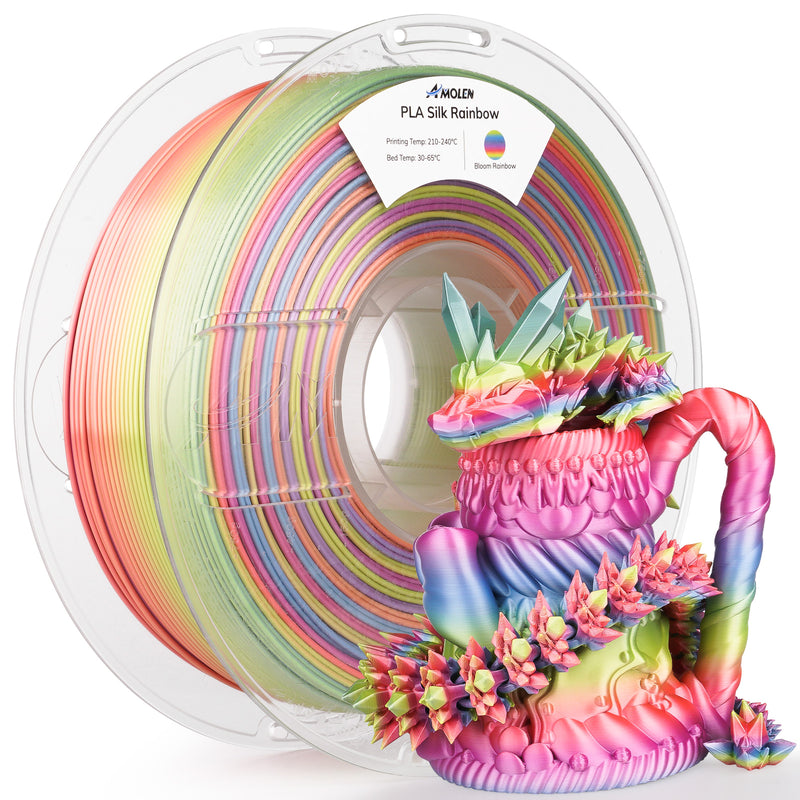Unleash Your Creativity: Discover the Magic of Silk PLA Filament in 3D Printing!
In recent years, 3D printing has surged in popularity, transforming how we create and design objects. From hobbyists to industrial applications, the ability to produce three-dimensional items has captured the imagination of many. One critical factor in achieving stunning and unique prints lies in the choice of filament. Among the various options available, silk PLA filament stands out due to its distinct properties and aesthetic appeal. This specialized filament not only enhances the visual quality of prints but also offers a range of practical advantages that can elevate your 3D printing projects to new heights.

Characteristics of Silk PLA Filament
Silk PLA filament is renowned for its luxurious sheen and smooth texture that set it apart from standard PLA. When printed, objects made from silk PLA exhibit a striking, reflective surface that resembles silk fabric, hence the name. This filament is typically available in a range of vibrant colors, allowing for creative expression and uniqueness in every project. Unlike regular PLA, which can often appear matte and dull, silk PLA adds a professional touch to your prints, making them visually appealing. Additionally, the printing process for silk PLA is user-friendly, with similar temperature requirements to standard PLA, typically around 190-220°C. This ease of use makes it accessible for beginners and seasoned 3D printing enthusiasts alike. However, it's essential to experiment with print settings, as the filament's unique properties may require slight adjustments for optimal results.
Applications of Silk PLA Filament in 3D Printing
The applications of silk PLA filament in 3D printing are vast and varied. Its aesthetic qualities make it particularly popular for artistic projects, including sculptures, decorative items, and cosplay props. For instance, a friend of mine recently created a stunning dragon figurine using silk PLA, which turned heads at a local convention due to its vibrant colors and shiny finish. Beyond artistic endeavors, silk PLA is also suitable for prototypes and functional items that benefit from enhanced visual appeal. Items like custom phone cases, jewelry, and even signage can be produced using silk PLA, showcasing the versatility of this filament. The exceptional finish can transform a simple prototype into a presentation piece, making it an excellent choice for showcasing designs in a professional setting.
Advantages of Using Silk PLA Filament
Silk PLA filament offers numerous advantages over other types of filaments, making it a favored choice among 3D printing enthusiasts. One of the most significant benefits is its environmental impact; being derived from renewable resources, silk PLA is biodegradable, which is a crucial consideration for eco-conscious creators. Additionally, the print quality achieved with silk PLA is often superior, resulting in smoother finishes and vibrant colors. This filament is also remarkably versatile, suitable for a range of applications from artistic to practical. Whether you're a beginner looking for an easy-to-work-with filament or an experienced user aiming for high-quality results, silk PLA is an excellent option. The combination of aesthetic appeal, ease of use, and environmental benefits makes it a standout choice in the diverse world of 3D printing.
Tips for Working with Silk PLA Filament
Here are some tips for working with silk PLA filament:
- Ensure your 3D printer is properly calibrated; this can significantly enhance print quality.
- Experiment with print settings, as some adjustments may be necessary for optimal results.
- Consider using a heated bed to reduce warping and improve adhesion.
- Don’t hesitate to apply a layer of glue stick or hairspray to help your prints stick to the build plate.
- Use a cooling fan to help with layer adhesion, but be mindful of over-cooling your prints.
- Post-processing techniques like sanding can be effective in enhancing the shiny finish of your prints.
- Be aware of stringing and adjust retraction settings accordingly.
Exploring the Creative Potential of Silk PLA Filament
In summary, silk PLA filament offers a delightful blend of beauty and functionality in the realm of 3D printing. Its unique characteristics, coupled with a wide range of applications, make it a valuable tool for both novices and experienced creators. The advantages of using silk PLA, such as its environmental benefits and superior print quality, further enhance its appeal. I encourage you to explore the creative possibilities that silk PLA filament can bring to your projects. Whether you're crafting intricate designs or practical prototypes, experimenting with this filament is sure to yield impressive results and unleash your creativity!








